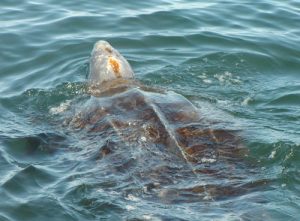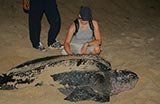Can the leatherback sea turtle be saved? An optimistic outlook
by Brittany Bartlett, RJD Intern
Many species that have been present on this planet for millions of years now face the possibility of extinction within the near future due to human activity. Among these species with uncertain futures is the leatherback sea turtle; a species some scientists believe may go extinct within our own lifetime (Spotila et al 1999).
All species of sea turtle found within the eastern Pacific Ocean are listed as vulnerable, endangered or critically endangered by the International Union for the Conservation of Nature. However, the critically endangered leatherback sea turtle faces the harshest reality due to its’ complex life history (slow growth rate, late reproduction, highly mobile movement), which complicates protection efforts. If the leatherback’s rapid rates of decline persist, scientists estimate that the global population of leatherbacks will be functionally extinct within the next few decades (Spotila et al. 1999).
So, why are leatherbacks so vulnerable to extinction, and is it possible to mitigate these threats to allow these incredible species to prevail?

Leatherback sea turtle on beach, By Steve Garvie from Dunfermline, Fife, Scotland (LEVIATHAN) [CC-BY-SA-2.0 (via Wikimedia commons)
Longlining is a fishing practice that consists of one large, primary horizontal line at the surface of the water, attached to hundreds (or thousands) of additional vertical lines with baited hooks that can reach depths of 400 meters. In 2000, approximately 1.2 billion longline hooks were used globally; 52% of these hooks were in the Pacific. Therefore, a high opportunity exists for the Pacific leatherback to bite and/or get caught in a line in passing (Gilman et al 2006).
Passive net fisheries are unselective fishing practices that utilize large, easy to use, cost effective nets. Fishermen deploy these nets in the ocean at various depths in attempts to catch various species of pelagic and coastal fish passing through. Sea turtles can become entangled and trapped in these nets, oftentimes resulting in drowning (Gilman 2009).
Although, this may seem grim, hope does exist. Fishing practices simply need to become more sustainable and consider sea turtle characteristics and behavior.
Time area closures may be one of the most efficient and feasible ways to reduce sea turtle bycatch within the Pacific. Satellite tagging operations have concluded the whereabouts of the highly migratory leatherbacks at different times of the year. For example, leatherbacks are present in the California Current System in the summer and autumn months due to an increase of jellyfish (their primary food) within the area (Bailey et al 2012). Restricting commercial fishing within this area from July to November can reduce the amount of sea turtle bycatch. One successful closure in the Oregon and California waters for loggerhead sea turtles foraging on red crabs was implemented and resulted in 0 reported bycatch for that season (Shillinger et al 2008)!
When fishing cannot be avoided, gear modification is the next best option. Currently, the fishing gear and strategies implemented by commercial fishermen are designed to catch the highest amount of fish at the lowest cost and per unit effort. This approach is often unsustainable, but modifications of these current practices can partially mitigate the incidental take of leatherback sea turtles.
With regards to longline fisheries, a change in hook type and bait could be a simple mechanism to reduce bycatch. Fishermen tend to use J hooks as opposed to C hooks (the C hook has a smaller, more inward gap then the J hook). Studies show that a hook with a gap less than 4.6cm can greatly reduce the amount of bycatch that is caught. Therefore, a shift from J hooks to C hooks has the potential to decrease leatherback bycatch by 75% (Gilman 2006).

A swimming leatherback sea turtle. By Scott R. Benson, NMFS Southwest Fisheries Science Center [Public domain], via Wikimedia Commons
The unselectively of passive nets could be modified in many ways. Two of the more recognized modifications are a reduction in the net profile and a change in net mesh size. A low profile net is half the depth of typical gillnets, reducing the amount of net within the water and opportunity for entanglement. The mesh size of a net influences the amount of non target species caught; reducing mesh size so sea turtles will not get caught can reduce bycatch by 32% (Gilman 2009).
As you can see, solutions do exist. The ones stated here are only a few of many possible options. Unfortunately, protection efforts and action to reduce the amount of leatherbacks caught in fishing gear is limited. This can, in some regards, be attributed to a lack of public concern and pressure. It is our responsibility to educate ourselves about current conservation efforts, raise awareness, and take action. It is in our hands to help inspire change and support efforts to increase protection for the critically endangered leatherback sea turtle.
REFERENCES
Gilman, E. et al. (2009) Mitigating sea turtle by-catch in coastal passive net fisheries. Fish and Fisheries
Gilman, E. (2006). Reducing sea turtle bycatch in pelagic longline fisheries. Fish and Fisheries 7, 2-23.
Shillinger, G. et al. (2008). Persistent Leatherback Turtle Migrations Present Opportunities for Conservation. Plos Biology 6, 1408-1416.
Spotila et al. (1999). Description of the Eastern Pacific High Seas Longline and Coastal Gillnet Swordfish Fisheries of South America, including Sea Turtle Interactions, and Management Recommendations. Sea Turtle Restoration Project.




Leave a Reply
Want to join the discussion?Feel free to contribute!